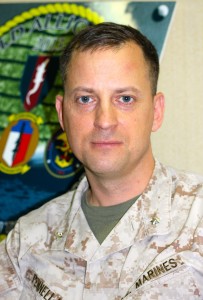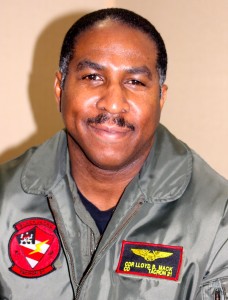2013-06-07 (Updated) Coordinating an amphibious task force is complex and challenging.
When the amphibious task force expands to become an expeditionary strike group supported by USAF and USN fires, coupled with C5ISR, it becomes even more complex.
The Bold Alligator 2013 exercise was synthetic based and is the latest effort to refine military elements working together to shape a coordinated outcome, or effect.
The USAF provided significant support elements to the maritime insertion force, and the large deck carriers along with the aviation and strike elements (including ground insertion “special forces”) worked together to shape the environment to allow for larger scale insertion of ground forces.
And the operation of the ground forces became a key element in allowing more effective strike operations by various air-breathing assets – airplanes and missiles – to ensure mission success.

In an interview with two members of the Bold Alligator Blue-Green team, the nature of the effort and the challenges to be met were discussed.
Lt. Col. Brad Penella and Commander Lloyd Mack worked together in the exercise on the fire effects function for the Blue-Green team. In the interview they did the same – operated as a team – so we will refer to their comments as the BG Team.
As the officers described the effort, fires were coordinated throughout the task force, with tomahawk cruise missiles used in both an initial strike and shaping role and then in a support role to the deployed forces.
During the shaping function task, the carrier strike group commander coordinated the aviation assets aboard the carrier and the amphibious ships and then transferred command to the ESG 2 commander for aviation support to the insertion force.
The USAF played a key support role in terms of C5ISR and tanking with its lift role for the 82nd Airborne, both to insert and then support by air dropping.
They described the challenge as follows:
In effect, we were exercising the single battle concept whereby the flow of forces from the carrier and the amphibs was being coordinated in an integrated manner.

They described a key line of development is to craft over time greater capability to incorporate the deconfliction of air tasks within integrated data systems.
They described how strike and air deconfliction requires significant coordination, and that more automation of the data generated will over time assist in the improved flow of force through the deployed ships.
And clearly what BA 13 was highlighting were the capabilities and potential for Naval and joint force projection and sustainment from a seabase in a way that has not been done since World War II or in the Korean War.
But here, the ground forces and strike forces are seen as an integrated whole, rather than a simple process of disembarking the ground troops.
You have to have forces on the ground to confirm everything that we’re doing. Systems are fooled all the time, until you get a ground force or air asset that can confirm or deny what’s going on.
Plus, the enemy can bury himself in the ground. The enemy above the ground is one thing, but he can easily go underground, too, especially in a well-developed, long-term country that has had time to build an underground network. The ground maneuver force ashore allows your supporting strike forces to be much more effective.

